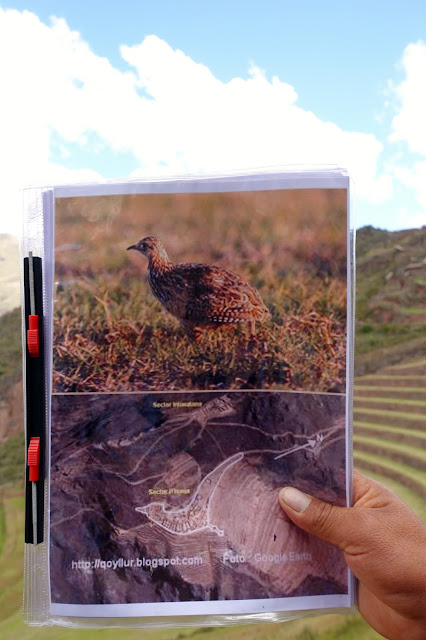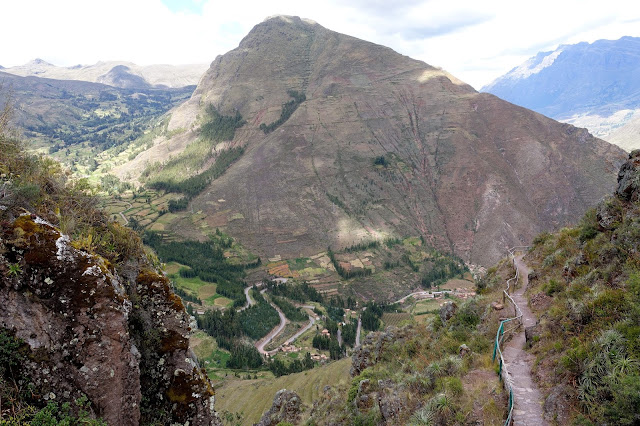Even though the scenery in Peru's Sacred Valley is spectacular,
the very best part of my day was meeting the People of Pisac.
the very best part of my day was meeting the People of Pisac.
Many Inca sites litter the landscape in this historic valley. The Inca people found the rich soil here to be ideal for agriculture, and settled in to be quite productive, building cities and crop terraces, forts and sanctuaries. We've hired a driver to go exploring for the day, our very own Juan Carlos ~ this is the guy we were expecting yesterday when Mr. Phantom Cab Driver showed up and kidnapped us instead (see the post "The Rest of the Story").
We are stopping to hike at the famous Pisac ruins, which dominate the mountainside above the little town. While it is possible to hike up from the town, we chose to be dropped at the top and hike down instead. I'm still fighting the signs of elevation sickness, so that's the best I can do. You can see the terracing all the way up the mountainside.
On the way up, we see these folks taking a break ~ they have made themselves a sunshade from the materials at-hand, it would seem.
It looks like they might spend quite a bit of time sitting here.......
It looks like they might spend quite a bit of time sitting here.......
At the gateway to the trail, we find a few local vendors selling their wares. Many wear the traditional clothing of the indigenous people of Peru.
It's here we find and hire a guide ~ it's one of those times that you wouldn't know what you're really looking at otherwise.
The fort at the top is easily identifiable ~
But, for example, I would have missed these ~ the holes bored in the rocks are actually "grave sites"; bodies of the deceased were folded up in a fetal position to take up less space. Real estate is evidently a valuable resource way up here on the mountain ~

~ Where all the good stuff was being used for crop farming.
Our guide is a very nice young man, local to the area. He makes (and played for us) this native flute, which certainly added some charm to our stroll along this ancient trail.

He offers us the customary coca leaves, which the natives all use to ease the symptoms of altitude sickness. I just never could get used to them ~ they tasted even worse than the altitude sickness felt; but Mr. C always accepted when offered. Must be a guy thing.
But I found it so interesting that he also offered me Manya oil, an essential oil that is also supposed to influence the dreaded altitude sickness. This, I do accept. Gratefully, and frequently.

This oil is made by his Grandmother ~ from this Manya plant ~
~ that's what I call true local "flavor" (pun intended) !
And here are the Inca terraces, visible for miles from down below. The enormity of this project is staggering. Building the terraces, then hauling rich topsoil up from the valley below, all at an elevation that tops 11,000 feet.
It's hard to comprehend, even while standing here.
Can you imagine living way up here?

There's lots of signs about, which we have not found to be frequent at most of the other old sites we've visited in Peru.
Some we understand; some seem unnecessary, but then, I also know that people can be stupid; And some just don't survive the translation to English.
Like this one. I would like to "respect the scans", but I just don't know how to respect the scans. 'Cause I don't know what they are. The scans, I mean. The signs? The boundaries? The banisters? What???
There's water here ~ of course there had to be a water source to support this whole mountainside community.
We get a lesson on moonstones.
Courtesy of Google Earth.
We go through the "arch", built from those same self-fitting stones that the Inca's are famous for. No mortar.
And up some stairs. This is all pretty rugged.
Not for the faint of heart, for sure.
 We go through a "tunnel" in the rocks. There's always a light at the end......It's a good reminder ~
We go through a "tunnel" in the rocks. There's always a light at the end......It's a good reminder ~
All of this was a part of the trail system that linked the major Inca sites together ~ from here to Cuzco, and on to Machu Picchu ~ their runners are unrivaled in history.
Signals could also be sent from the mountain tops from one local to the next, and then forwarded to the next.
 |
He draws a diagram for us in the dirt illustrating this system. |
We are spellbound.
Don't you just want to meet them? The Inca's, I mean.
I know I do.
Now it's time to start our descent. It looks like a looooong ways to the bottom of the hill. Another big sigh.
There are still Indigenous people living and farming in the hills up here, some 60 families or so; you can see the tended fields in the background. Remember, we're more than 2 miles high at this point. It would be like living and farming on the top of Mt. Hood.
This young mother has come down to the trail in hopes of selling a few trinkets to tourists like us; and we happily oblige. Oh, that beautiful baby!! She captured my heart the instant I laid eyes on her. It's one of my favorite photos of the entire trip, this perfectly beautiful little Peruvian child.
Now we come upon the ruins of the main "village". It's here we will say goodbye to our guide ~ we will continue on down the mountainside to town; he will return to the top of the mountain and hope for more tourists to tell the story of Pisac.
And still more on the way down. I am relieved that Mr. C does not suggest we climb these additional stairs......we are, after all, supposed to be headed down the mountain. I'm looking forward to being able to breathe again.
We decide we need bathrooms and a snack (in that order of importance); and a cold beer wouldn't hurt, either. Juan Carlos takes us to a little cafe ~ where this gentleman heats up my empanada in this old brick oven.

We can't eat too much, though......there's guinea pig on the menu later today......
(see the post "Cuy, Peruvian style)
I have to say that I enjoyed Pisac nearly as much as Machu Picchu.

But that's probably because of the people of Pisac that we met along the way ~

































This article is full of wonderful travel information as well as great photos! I am amazed at the terracing. Oh so much work. The photo of the baby is a favorite of mine and the mother looks so young! I really enjoyed reading this!!
ReplyDeleteThanks, Karen, Pisac was one of my favorite spots in Peru. And I agree, I think she looks like a very young mother. I've been reading that "child brides" were customary back in the day, as young as 9 or 10; because they had to decide by 12 years old whether too be a nun! I'm not suggesting that's still the case, but I think it's not unusual for the girls to marry in their teens. I thought she was just as beautiful as the baby ~ and I can't imagine carrying those babies (and toddlers!) on your back like that in those hills!
Delete